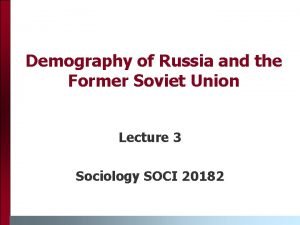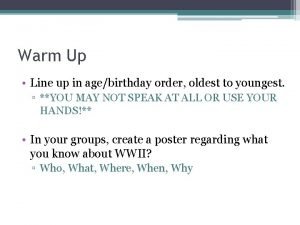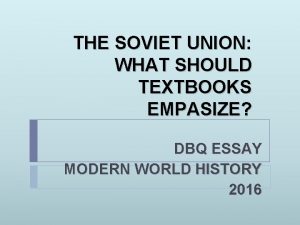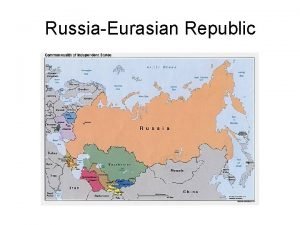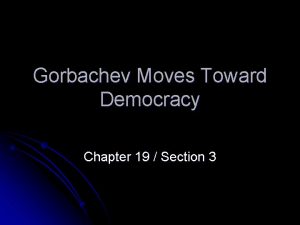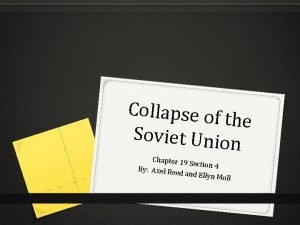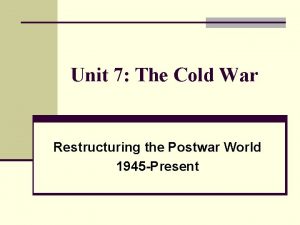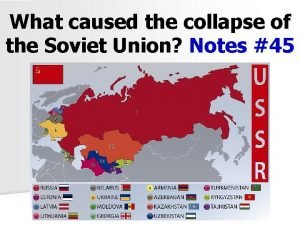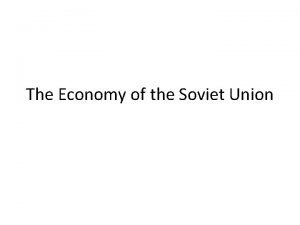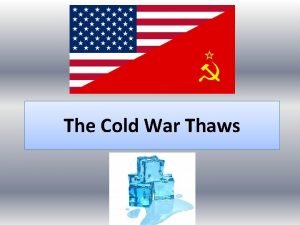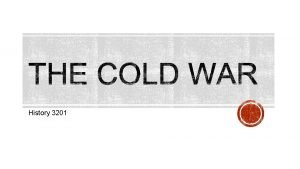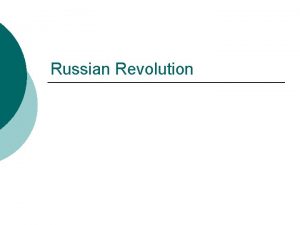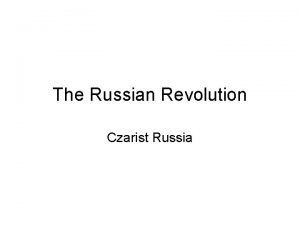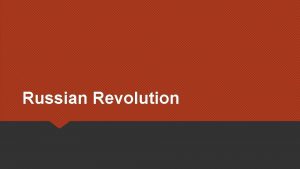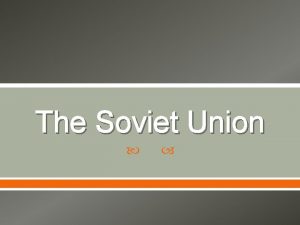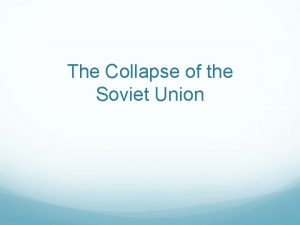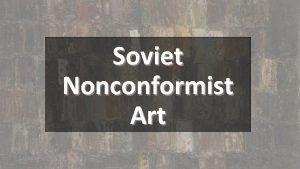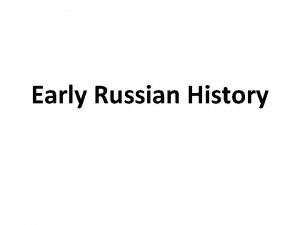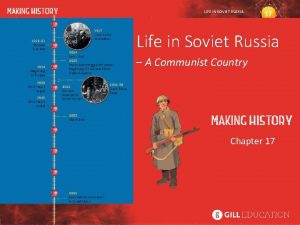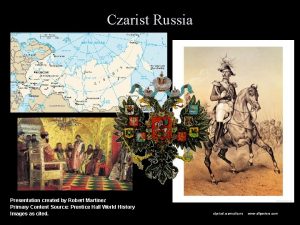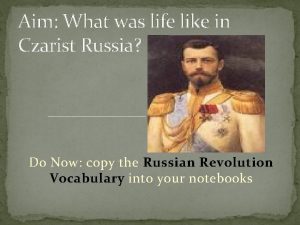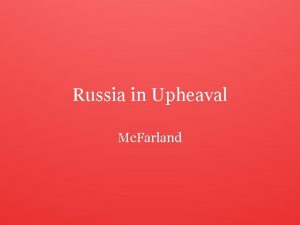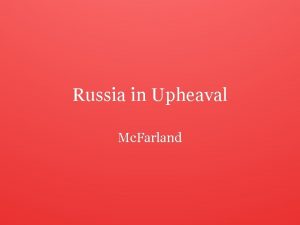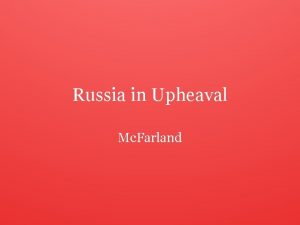Russian History Three Eras Czarist Russia Soviet Union














- Slides: 14

Russian History Three Eras: Czarist Russia, Soviet Union, & Russia Today

CZARIST RUSSIA Ivan III (Ivan the Great) 1462 -1505 Conquered territory around Moscow, tripling the size of Russia l Liberated Russia from Mongols l Laid the foundation for absolute monarchy l

Ivan the Terrible (ruled: 1547 -1584) l Grandson of Ivan III l Strengthened the monarchy: first “official” czar of Russia. l Laws restricted the mobility of the peasants, which would eventually lead to serfdom l Added territory, unified Russia l Created a code of laws l Ruthless: Exiled or executed many of his nobles at the slightest provocation.

Peter the Great (ruled: 1672 -1725) Gains territory, transformed Russia into a world power l Looks to Western Europe for changes l Introduced the potato l Started a newspaper l Raised women’s status l Introduced western clothing to Russia l Opened schools – arts & sciences l

Catherine the Great Catherine II (Ruled: 1762 -1796) v. Most admired of all the Russian rulers. v. German princess who married a Russian prince. v. Educated and well read v. Expands empire to Black Sea area.

prepared for the Nicholas II Notresponsibilities of the (rule: 1894 - throne. Did not allow representative 1917) power of the people. Russia went from a great power to an economic & military disaster (WWI) Accomplishments: l Trans Siberian Railroad (see map left) l Factories doubled 18631900

Events leading up to the Russian & Bolshevik Revolutions 1917 a series of revolutions that led to the dissolution of czarist Russia l l l Bloody Sunday 1905: Demonstrators petitioning the palace were gunned down. Extreme Poverty of the freed serfs, food shortages WWI (1914) – Russia forced into war, suffered huge losses & social & economic problems worsened. Nicholas abdicated in 1917. In 1918 he & his family were murdered by the Bolsheviks (Communists). The next 75 years Russia was dominated by “Rule by Fear” & by men like Lenin & Stalin…

Lenin’s Take Over (chairman 1917 - 1924) The First Head of the Soviet Socialist Republic Introduced a series of reforms: New Economic Policy (NEP) l Allow individuals to buy and sell for profit l Gov’t controlled major industries, banks, communications l Farmland was seized from wealthy, divided among the peasants - encouraged collective farming Reforms: Women received equal pay Education important – stressed socialist doctrine, technical schools Religion was discouraged

Joseph Stalin (chairman: 1924 -1953) Stalin ended the NEP Returned to command economy 5 Year Plan l Goal – turn Soviet Union into a modern, industrialized society l Collective farming failed – famine crop failure millions died l Steel production increased significantly l Purges – a large scale elimination of enemies. l Estimated 5 million were arrested, deported, or executed between 1934 -1939 l l l

Problems of the New Soviet Union Problem Attempted Solution Results Near economic collapse Lenin’s NEP Moderate success Agriculture Collective farms Failed; famine Power struggle – Stalin and Trotsky Savage and brutal competition Stalin emerged as victor Little economic growth Stalin’s first 5 year plan No increase in consumer goods Second 5 year plan Succeeded n reviving industry somewhat Industry grows – people starve

The Cold War (1945 -1991) This “war” was a battle of words and rising armaments between USSR and US. l Specific events during the Cold War intensified hostilities, or decreased them. l It ended with the fall of the Soviet Union in 1991 l

Fall of Communism l l l Mikhail Gorbachev head (“Premier”) of the USSR 19851991 Relaxed economic control Reduced military spending Introduced reforms – l Glasnost: openness by the gov’t & l Peristroika: political & economic reforms Results: l Increased tensions between ethnic groups l People began demanding more and more freedom and independence. l 1991 Soviet Union ceased to exist

Yeltsin (president: 1991 -1999) l First elected President l Transformation democracy l High to inflation l Unemployment l Food and housing shortages l Open Russia to foreign investment l Privatized industry

Vladimir Putin l Leader of Russia since 2000 l He increased GDP by 72% l Real wages tripled during his first two terms in office. • However, he rules like a dictator and after he hand-selected his successor in 2008, he ran for another term in 2012 which was increased from 4 years to 6. • Countries around the world including the US worry about his leadership
 Eras of russian history
Eras of russian history Russia depopulation
Russia depopulation Meanwhile in soviet russia
Meanwhile in soviet russia Acrostic poem cold war
Acrostic poem cold war Soviet union what should textbooks emphasize
Soviet union what should textbooks emphasize Russia and the eurasian republics
Russia and the eurasian republics Gorbachev moves toward democracy
Gorbachev moves toward democracy Chapter 19 section 3 the collapse of the soviet union
Chapter 19 section 3 the collapse of the soviet union Soviet union develops atomic bomb
Soviet union develops atomic bomb Soviet union countries
Soviet union countries Soviet union
Soviet union Soviet
Soviet Soviet union acrostic poem
Soviet union acrostic poem Soviet union
Soviet union Containment ussr
Containment ussr

